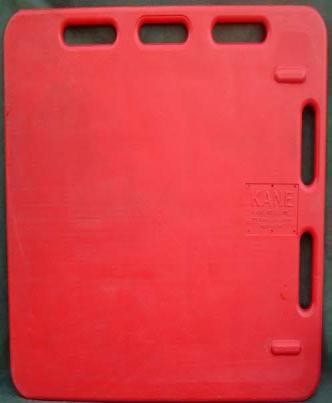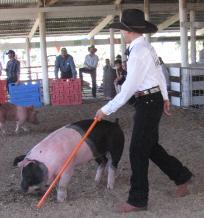Swine Showmanship Guidelines
SWINE SHOWMANSHIP
Showmanship is an exhibitor’s ability to most effectively present an animal in a competitive show ring environment. Swine showmanship not only generates enthusiasm in the show ring, but also teaches many valuable lessons that can be used in day-today life. Remember you are trying to promote the swine industry as well as yourself, your family, your club and 4-H.
Successful showmen start training at home early. As soon as you purchase an animal, it is important that your animal starts to build trust with you. This is less stressful for you and the hog and ensures that you both are ready for show.
Grooming Swine
- Wash your pig during warm weather several times beginning at least two weeks before the show.
- Use a mild soap and water solution. During wet weather, don’t wash the animal. Use extra brushing or grooming to clean the animal. Pay special attention to cleaning the ears, feet and eyes.
- Groom hair to lie in its natural direction. Frequent and thorough brushing will improve the appearance of the hair coat. Use a stiff brush initially to clean the skin and hair but switch to a softer brush for final grooming. If you choose to clip your animal, it is recommended you leave at least ½ inch of hair.
- To give the pig a glossy hair coat, you can apply a small amount of transparent oil, such as mineral oil. Never leave a large amount of oil on the pig. The best way to apply oil is to soak a rag with it and rub it over the pig. If you apply too much oil, you can use a dry rag to rub some off. White areas on dark pigs and white pigs can be dusted with a white powder, which gives the pig a nice appearance. Oil or powder should be worked thoroughly into the hair and should be applied lightly. If the judge touches the animal, his hand should not become oily or dusty. Good washing and brushing will lessen or eliminate the need to use oil or powder.
- If the pig’s hooves are long, trim them to the desired length. This should not be necessary in market hogs. Trim gradually over a period of time to avoid foot injury.
- Carry a small brush into the ring in case your pig becomes soiled on the way to the ring or while in the ring. Before entering the ring, be sure your pig is brushed clean of all bedding and dirt, clean the feet of excess mud or manure, and be ready when your class is called.
Checklist for Preparing for Show
- Animal should be clean and free of stains and dandruff.
- Ears, feet and legs should be clean.
- Hair should be brushed in the natural direction it grows.
- Oil can be applied to the skin if it is dry and flaky.
- Some clipping can be done on the tail or ears however this is optional. ½ inch of hair is preferred on market hogs.
- Have proper show equipment ready for show.
Showing Swine
Equipment:
A Driving Tool – A driving tool is needed to guide or drive your hog. Do not overuse the driving tool. Hog whips and plastic piping are acceptable driving tools. Your driving tool should be three to four feet long. Your hog should be well trained, so the driving tool is used limitedly. Use the tool on the pig’s side of jowl to turn the pig and on the mid-rib and lower belly to move the hog forward. Some swine showmen use their dominant hand to hold the driving tool regardless of which side of the pig they are on, while others switch hands as they switch sides. Both methods are acceptable as long as switching hands is done smoothly.
- NEVER hit your hog with your driving tool, merely tap the hog.
- Be careful NEVER to use the driving tool on the pig’s top. Pig skin is tough, but the softest skin is on the back and this is also where the highest valued meat comes from.
- NEVER use the driving tool on the ham.
- NEVER use the driving tool on the hock of your animals. The hock is susceptible to injury and could result in a lame pig
- Do not overuse your driving tool. Allow your hog to walk naturally.
Driving tools: long whips and plastic piping.
![]()
Long whips with a tether on the end are recommended.
![]()
Whips with flappers on the end are not recommended driving tool for hogs. They are
noisy and unprofessional.
![]()
Plastic piping
Livestock Canes are no longer recommended. They are bigger and harder to handle and increase the chance of bruising hogs.
Small Hand Brush – A small hand brush is essential while showing a pig. Pigs will rub against one another and get dirty or the judge may sprinkle your hog with shavings. As a showman it is your responsibility to keep your animal clean with your brush. Brushes can be placed in your less dominant hand or in your back pocket. Placing the brush in your back pocket is preferred method because it frees up your hand.
Spray Bottle – A spray bottle of water may be used to groom and cool the hog. However, do not take the bottle into the ring during the show.
PIG BOARDS: Fighting hogs may occur during a show when a group of hogs engage in a fight. DO NOT jump between fighting hogs. You may use your driving tool to assist in controlling the situation. A ringman will use a board to further separate fighting animals. Remember keeping yourself and other exhibitors safe is the number one priority.
 pig board
pig board
Showing Procedures
- By the time you enter the show ring, your hog should be well trained to drive and act correctly.
- Exhibitors must drive their hog with complete confidence control.
- When driving, you should be on the hog’s side which is opposite the judge. Always keep the animal between you and the judge.
- Do not “over-show” your animal. A judge will not be impressed if you always block everyone else’s view or over maneuver your animal. Furthermore, your animal will become irritable.
- Observe where you are going in the show ring and look to see that you are driving your pig in the open area with adequate distance from the other hogs. Good showmen are constantly looking for openings in the ring to drive their hog, keeping their pig off the fence, and away from group of pigs and out of corners.
- During the drive, the hog’s head should be just high enough to present an impressive style, attractive side view and graceful walk. Working on keeping your hog’s head up, but its head should not be carried to an extreme that can be distracting or that keeps your hog from moving at a good pace.
- Keep your pig 10 to 20 feet away from the judge, and never at the judge’s feet.
- Walk at a moderate pace and straight ahead. Let your hog walk naturally, not too fast, and not too slow. The exhibitor should also walk with a natural step.
- While the judge is appraising your animal, he or she could walk around your animal. It is important you are aware the judge is coming. If the judge comes from the right side of your animal around the front of the animal’s head, walk behind the animal to reach the right side as the judge comes even with the head of the animal. This allows the judge to see more of your animal and lets them know you are aware of their location. Move the opposite way if the judge comes from the opposite side.
- When driving a hog, there are three views that should be shown to the judge: the rear view, side view, and front view.
- Show from the hip of your hog. Do not walk directly behind the pig and look like you are following it.
- NEVER step over your pig to get on the other side of it.
- When showing, stand upright with a relaxed posture at the hip of your hog. Your free
hand should hang naturally while your other hand uses the driving tool. Never lean
back when showing. Leaning slightly forward is acceptable.

Pig should be positioned 15 to 20 feet from the judge.

NEVER step over your pig to get on the other side of it.
USING YOUR DRIVING TOOL:
- The driving tool should be used without drawing attention to your hog or to the tool being used.
- Touch the animal from the fore rib forward (shoulder and jowl area) to turn your pig. Touch the left side of your animal if you want it to turn right and touch the right side of your animal if you want it to turn left.
- If your hog is well-trained your driving tool is merely a guide and you will not have to touch the hog.
- Using your hand to guide your hog is also acceptable and is an encouraged showmanship technique specially to drive your hog out of the corner of the show ring. Always remain calm and simply place your hand or hands in front of the hog’s face to assist in turning it away from the corner.
Turning a hog. If you work with your animal before the show, your animal will turn naturally by just placing your driving tool next to their jowl.
PENNING YOUR PIG:
Be observant for signals and instructions from the judge and the ring official. Often, a judge will ask you to pen your pig.
- Naturally walk your pig to the assigned area as quickly and efficiently as possible.
- Open the gate when you have driven your pig close to the pen, pen your pig, then close and latch the gate behind you.
- While in the pen, keep showing.
- The proper technique while in the pen is as follows:
- First, address the cleanliness and well-being of your pig by brushing them off.
- Stand behind your pig, keeping your eye on the judge for instructions to reenter the ring.
- The pig should be at a side view in the front of the pen by the gate, with its head at the end where the gate will open. This position allows the judge to see the hog and your pig is pointed in the direction needed for an easy exit.
- The judge may enter the pen with you and ask you questions about your pig and the swine industry.
- When the judge signals for you to leave the pen, open the gate and shut it behind you.
General Tips for Swine Showmanship:
- Avoid allowing your hog to root around in the dirt.
- Using your driving tool properly is an important key to showmanship. Do not overuse your driving tool and never hit your animal with your driving tool.
- Keep the animal between you and the judge.
- Your pig should never run.
- Restrain the hog from fighting with others.
- Every time the judge handles your pig, use your brush to reposition the hair, then put the brush back in your pocket.
- Be prepared to answer questions about your animal and the swine industry.
- Refer to all other General Showmanship Guidelines on pages 1-3 and your county or show rules.
